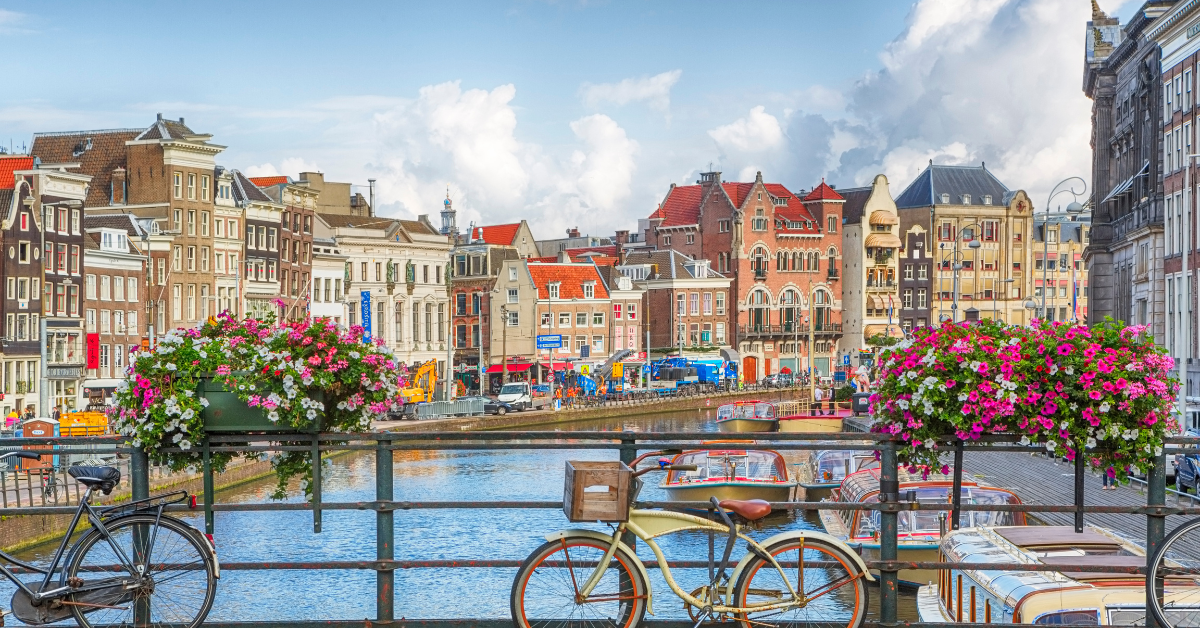Amsterdam, the capital of the Netherlands, is often associated with art, canals, and freedom. While Japanese people usually write it in Katakana, the city also has a unique Kanji form, “阿特堤”, which carries both sound and meaning. Understanding this expression reveals how Japanese people perceive the city as a place of culture, beauty, and innovation.
The Kanji Representation “阿特堤”
Amsterdam’s name in Dutch means “Dam on the Amstel River.” The Kanji version “阿特堤” combines both sound and meaning, making it especially distinctive.
- 阿 … Represents the sound “A,” giving a soft beginning
- 特 … Pronounced “Toku,” reflecting part of the city’s name
- 堤 … Means “embankment,” symbolizing the dam and river connection
By using Kanji, the name goes beyond a simple phonetic translation, carrying the historical and geographical meaning of the city’s name.
The Image of Amsterdam Among Japanese People
For Japanese people, Amsterdam evokes a wide variety of associations.
| Image | Details |
|---|---|
| City of Canals | Known as the Venice of the North, with UNESCO-listed canal networks |
| Art and Culture | Van Gogh Museum, Rijksmuseum, and Rembrandt’s heritage |
| Bicycle City | Cycling is the main mode of transport, with extensive bike lanes |
| Flower Gateway | Tulips and flower markets symbolize Dutch horticulture |
| Free Society | A liberal, tolerant atmosphere shaping its global image |
These impressions, often reinforced by travel guides and word of mouth, shape how Japanese people perceive Amsterdam as a city of art and freedom.
Amsterdam and Sports Culture
Amsterdam is not only a city of art but also a hub of sports.
| Sport | Features & Achievements |
|---|---|
| Soccer | Home to Ajax, one of Europe’s most famous clubs, producing legends like Johan Cruyff |
| Olympics | Hosted the 1928 Summer Games, where the Olympic Torch Relay was introduced |
| Cycling | Deeply tied to everyday life, making the entire city a natural training ground |
| Athletics & Marathon | The Amsterdam Marathon is an internationally renowned event |
Ajax, in particular, enjoys high recognition in Japan, and watching a live match at their stadium is considered a highlight for visiting soccer fans.
Tourism and Experiences in the City
Amsterdam blends tourism with everyday culture, allowing visitors to experience both leisure and local lifestyle.
| Experience | Traveler Impressions |
|---|---|
| Canal Cruise | Scenic city views by day, enchanting illuminated canals by night |
| Museum Hopping | Exposure to masterpieces by Van Gogh and Rembrandt |
| Soccer Match | Stadium atmosphere is electrifying, unlike anything in Japan |
| Bike Rental | Touring the city like a local creates a sense of immersion |
This combination of tourism and authentic local activity makes Amsterdam unique compared to other European cities.
Lifestyle and Health-Conscious Living in Amsterdam
The bicycle culture in Amsterdam is inseparable from its citizens’ lifestyle, health, and environmental awareness.
| Aspect | Feature |
|---|---|
| Transport | Dedicated bike lanes used by all age groups |
| Health | Natural exercise embedded in daily life, contributing to low obesity rates |
| Environment | Reduced dependence on cars, fostering sustainability |
| Tourist Appeal | Visitors can experience the same rhythm of life through bike rentals |
This lifestyle resonates strongly with Japanese perceptions of Amsterdam as a progressive and livable city.
Why Amsterdam’s Appeal Is Spreading
The city’s rising reputation in Japan is influenced by multiple factors.
- Accessibility: Schiphol Airport serves as a major European hub, with direct flights from Japan
- International Standing: Multilingual services and tourist-friendly infrastructure
- Media Exposure: Frequent appearances in films and television enhance its image
- Event Spotlight: Soccer tournaments and flower festivals capture media attention
Together, these aspects make Amsterdam an accessible, memorable, and globally appealing city.
Conclusion
Amsterdam, uniquely written in Kanji as “阿特堤”, represents both its phonetic sound and the meaning of its name. For Japanese people, Amsterdam is not only a city of canals and art but also a sports capital, symbolized by Ajax and the Olympics.
With art, nature, sports, and freedom coexisting, Amsterdam offers a multifaceted charm. For travelers, it provides both cultural depth and active experiences, ensuring that each visit brings new discoveries. Going forward, its presence will continue to expand internationally across both cultural and sporting spheres.






